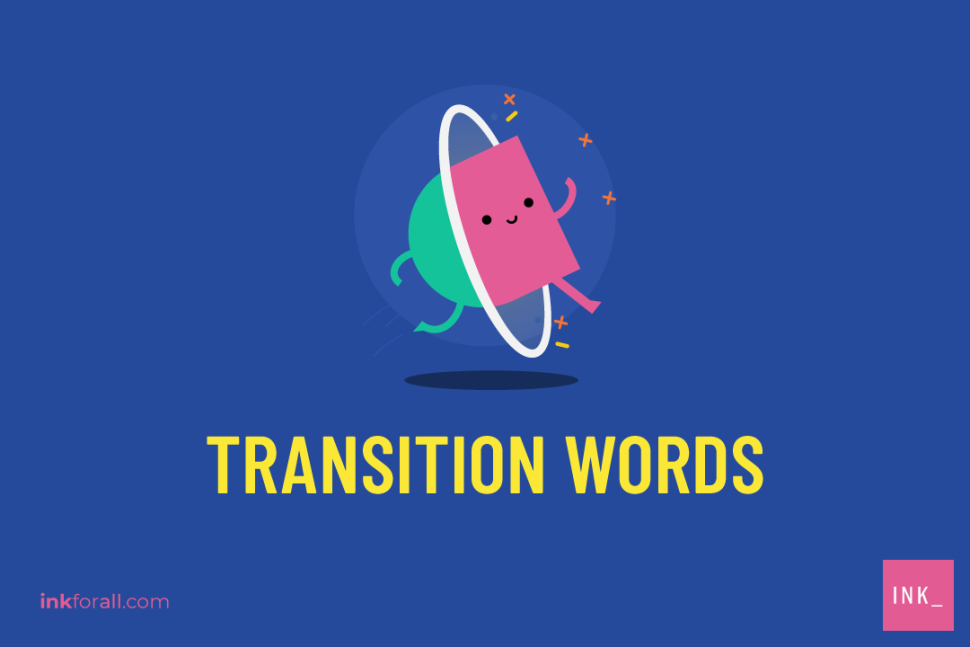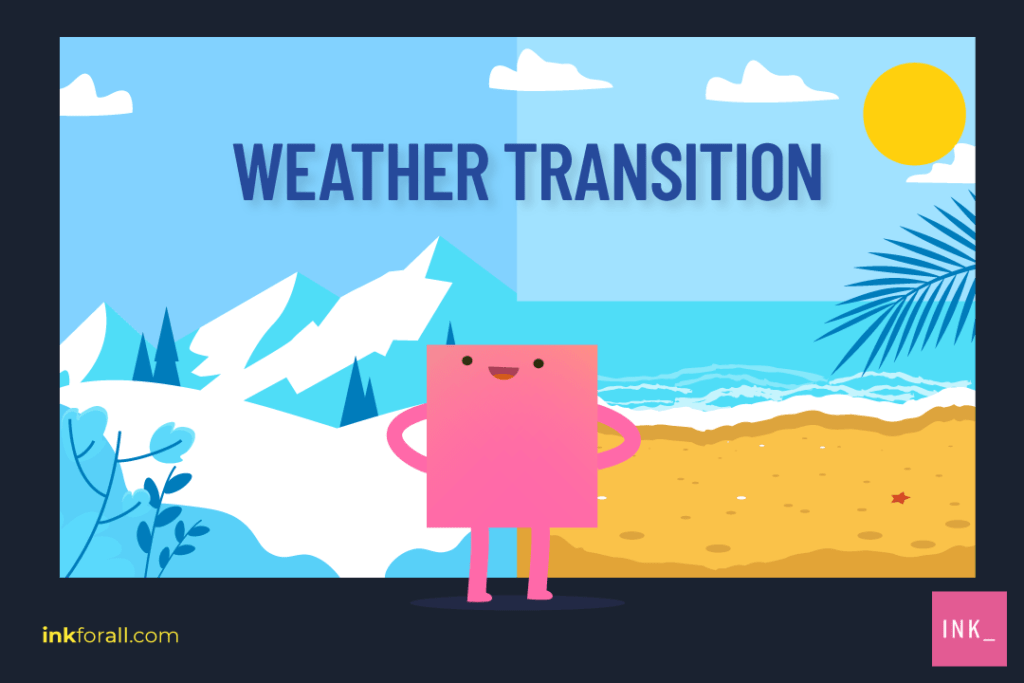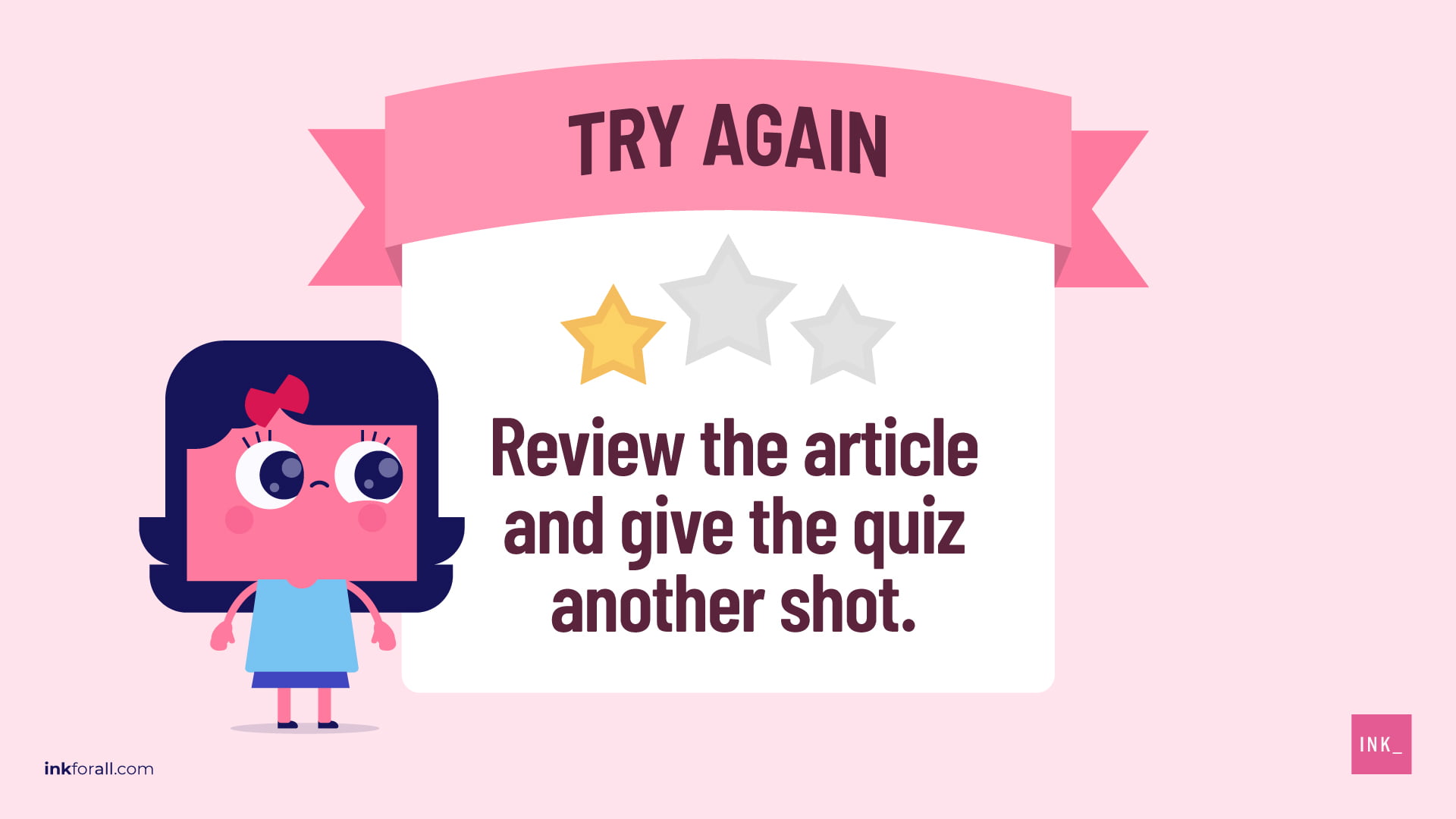Main Transition Words Takeaways:
- Transitional words are important because they help improve the flow between words, phrases, sentences, and paragraphs.
- They are important for SEO because they help make text easier to read and understand. Search engines and readers love content that is readable.
- Transition words help link ideas and statements.
- Using transitional words at the beginning or end of a paragraph can help the reader understand when you introduce a new topic.
- The four types of transition words are additive, adversative, causal, and sequential.
- Transition words and phrases don’t affect the grammatical structure of sentences and paragraphs.
What Are Transition Words?
As a writer, your primary goal is to present information and ideas to your target audience in a clear and understandable manner. The best way to do that is to use transition words. Transition words or transitional words are terms and phrases that help connect words, phrases, and even sentences together. They build connections between ideas in your content.
Transition words and phrases ensure that your written work will not look choppy and disjointed. They help your audience progress from one idea to the next. Think of them as a way to tell your readers how they should process and understand the information you are giving them. Transition words function like GPS, guiding your readers where they are going and how to get there.
What Are Some Examples Of Transition Words and Phrases?
Here are some of the most common examples of transition words and phrases:
Not to mention
Equally important
As a matter of fact
Not only/But Also
In addition
In fact
For example
What is more
In particular
On the other hand
When in fact
But even so
Whatever happens
In any case
Because of
Due to
In the event that
With this in mind
To conclude
By the way
To return to the subject
As has been mentioned
Given these points
Transition words are categorized based on their purpose. For instance, transition phrases like as a result of, due to, and as long as are used to emphasize cause and effect. Below are more examples of transition expressions that have been categorized based on their functions:
Cause and Effect
granted that
as long as
for the purpose of
in order to
in view of
as a result of
due to
because
therefore
consequently
so
accordingly
thus
hence
Since
for
owing to
as a consequence of
leads to
contributes of
stems from
comes from
results from
Evidence
as well as
and
too
also
in addition to
or
not only… but also
further
furthermore
besides
in addition
moreover
then
again
finally
by the same token
identically
uniquely
certainly
truly
including
to be sure
namely
chiefly
Contrast
however
on the other hand
otherwise
but
unlike
conversely
in spite of
at the same time
nevertheless
alternatively
on the contrary
yet
whereas
apart from
even so
although
while
Comparison
as
as if
similarly
equally
like
in the same way
comparable
as with
of contrast
despite this
in comparison
in contrast
even though
likewise
in like manner
Opinion
I feel
I believe
in my opinion
as fast as I know
in my experience
as for me, I think
if I’m not mistaken
I think
in my view
it seems likely
it seems to me
what I mean is
i’d say that
Similarity
moreover
as well as
together
of course
likewise
comparatively
correspondingly
similarly
furthermore
additionally
Clarification
that is to say
in other words
to clarify
that is
to explain
to put it another way
to rephrase it
in this case
I mean
up to a point
under certain circumstance
Sequence/ Order
first
second
next
finally
at this time
following
previously
before
prior to
before
Time
later
after
before
soon
meanwhile
during
subsequently
after that
at the present time
sooner or later
in due time
as long as
in the meantime
in a moment
at this instant
from time to time
Condition / Purpose
provided that
given that
in case
even if
only if
so as to
in as much as
when
whenever
if… then
unless
because of
as
while
lest
since
Emphasis
also
especially
furthermore
indeed
in addition
in particular
certainly
of course
significantly
notably
in fact
actually
in reality
as it happens
Conclusion
in conclusion
to conclude
finally
summarizing
overall
on the whole
to sum up
evidently
briefly
in short
altogether
in summary
to summarize
Place
here
there
over there
under
beyond
to the left
opposite
in the distance
Illustration
such as
in this case
for one thing
for example
in the case of
illustrated by
as an example
for instance
in other words
as revealed by
an instance
to show that
Reservation
admittedly
even so
as a matter of fact
indeed
nevertheless
even though
despite this
notwithstanding
regardless
What Are Some Examples of Transition Sentences?
The best way to understand how transitional words work is to see them in action. Remember, as important as these grammatical tools are, it’s not a good idea to overuse them. Too many transitional phrases can make your text seem complicated and wordy. It could also make you seem like a chronic overexplainer, and nobody wins when that happens.
You can use transitions to go from sentence to sentence:
You can also use transition words and phrases to go from paragraph to paragraph:
What Are the Four Types of Transition Words?
There are a lot of different ways to categorize transition words. In this post, we will discuss the four main types of transition words: Additive, Adversative, Causal, and Sequential.
1. What are Additive Transitions?
These transition words add or introduce another idea. They may also reference a previously mentioned concept, identify a similarity, or clarify an idea. Additive transitional words include:
2. What are Adversative Transitions?
Adversative transitions may be used to signal opposing ideas or dismiss a previously discussed idea altogether. Some adversative transition words include:
3. What are Causal Transitions?
As for causal transitions, they’re most commonly used to denote cause and effect. They may also indicate the reason an idea or action is happening or has happened. Causal transition words include:
4. What are Sequential Transitions?
As the name suggests, sequential transitions are used to put a sequence of ideas in order (usually chronological). This helps the reader understand where ideas fall in a list or when you’re wrapping up your text. Sequential transitions include:
Are Conjunctions Considered Transition Words?
While conjunctions and transitions share the same purpose — to connect ideas between or within sentences — they are not used the same way. You must not confuse conjunctions with transitional words or expressions. Conjunctions connect phrases and clauses, whereas transitions indicate the relationship between sentences and paragraphs. Check the following examples:
Subordinating conjunctions connecting dependent clauses with independent clauses:
Read More: The Easiest Way To Get Subordinating Conjunctions
Coordinating conjunctions connecting two independent clauses:
Transition words connecting sentences and paragraphs:
Another significant difference between transitions and conjunctions is their grammatical functions. Since conjunctions join clauses, they become part of the sentence and affect it grammatically. On the other hand, transition words have no impact on the grammatical structure of a sentence or paragraph. In short, you can remove a transition word, and it won’t have any impact on the sentence at all. Check the examples below:
Do Commas Go Before Or After Transition Words?
The placement of commas when using transition words will depend on where the latter appears in your text.
If your transition phrase appears at the beginning of the sentence, it is always set off with a comma.
If the transition word or phrase appears within an independent clause, it should be preceded by and set off with a comma.
If the transitional word appears between two independent clauses in a compound sentence, it should be preceded by a semicolon and set off with a comma.
How Are Transition Words Used in SEO?
SEO, or search engine optimization, is a process that involves optimizing your content for search engines to help improve ranking. The higher you are in search results, the more visibility your content will have. The more visible your content, the more people will see and learn about your brand.
Unlike keywords or meta tags, transitions between sentences or paragraphs don’t directly help boost your search ranking. Instead, it’s all about readability and structure.
See, Google runs on algorithms and those algorithms are big fans of order and ease of use. In other words, clarity is everything.
In the olden days (you know, like the 2010s), Google was like a heat-seeking missile for keywords. Basically, the more keywords you could stuff in your copy, the better you’d rank. That led to a lot of web pages that said something like, “buckets buckets buy some buckets buckets for sale the best buckets.”
What are they selling? You guessed it: buckets!
Google (and the rest of the world) soon realized the keyword stuffing wasn’t really good for anyone. Instead, search engines began focusing on how web pages could best serve the reader. Now, algorithms analyze web content for readability, and transition words play a huge role in that determination.

Transition Words Give Direction
Transition words also help you structure your content. Remember our road map? Transitional words can act as street signs, pointing readers left or right, directing them to take a U-turn, or propelling them onward.
Bottom line: Transition words make your content easier to read and understand. For this reason, it’s vital to rely not only on helpful tools but also on your own mind. If it reads well to you, it’ll likely read well to your audience.
Transition To a Closing
Finally, you can use transitions to introduce a new section or conclude your previous one—or wrap up the entire text. You may even use a transition to reinforce the general idea of your content before ending your piece:
Quick Transition Words Grammar Quiz
Transition Words Question #1
A. Causal
B. Additive
C. Adversative
D. Sequential
Correct!
Wrong!
The correct answer is letter C. Adversative transition words may be used to signal opposing ideas or dismiss a previously discussed idea altogether.
(E.g., but, however, conversely, still, and besides)
Causal Transition Question #2
A. Additionally
B. Consequently
C. Either way
D. To illustrate
Correct!
Wrong!
The correct answer is letter B. Consequently along with words like for, since, unless, as a result, and hence are all causal transition words.
(E.g., «Flexible workers often find themselves in great demand, and consequently, earn high wages.»)
Transition Words in SEO Question #3
A. They make content more interesting.
B. They make content easier to read.
C. They help increase word count.
D. Trick question! They’re not important for SEO at all.
Correct!
Wrong!
The correct answer is letter B. Transition words help improve the flow of ideas within a piece of content, making it more readable and easy to understand. Content with a high readability score can boost your SEO.
Transition Words Quiz Result
You’re an expert!
Not Bad!
Almost got it! Review the article and try again.
Read More: How to use a question mark (?)
Author: Michael L
Date: Oct 3, 2019 | Grammar
Transition words and phrases are an important part of the English language. They are used to connect words and sentences, often by referring back to one idea and signaling the introduction of a new one. Transition words can also help a passage of writing flow better, although it is best not to overuse them.
Consider the example:
- James did not go to the movies. He visited his grandparents instead.
The transition word in the above example is instead. It links the two sentences together by referring back to the first sentence and signaling that an alternative idea has been introduced.
Consider the example without the transition word:
- James did not go to the movies. He visited his grandparents.
The lack of a link between the two sentences leaves things a bit vague. We do not explicitly know that the two sentences are related, whereas the previous example shows that James visited his grandparents as an alternative to going to the movies.
There are 100s of transition words and phrases in English. Indeed, because of the evolution of language over time, new transition phrases can appear all the time. Often transition words are conjunctive adverbs – words like however, also, indeed, instead, still, therefore – or phrases containing conjunctive adverbs, conjunctions and adverbs. The point is that transition words cover a wide variety of language, but it’s more important to recognize their function rather than categorize them.
When to Use Transition Words?
Fundamentally, we use transition words to connect sentences and words together. They often refer back to the previous sentence or words within a sentence, and let the reader know that there is some related or new information on its way. There are different types of transition words and phrases, and not all of them have this simplistic explanation for their use.
Consider the passage below, and notice the highlighted transition words and phrases:
I do not like dairy products very much, particularly cheese. However, I make an exception for ice cream, especially chocolate ice cream. Indeed, ice cream is probably my favorite thing to eat. Admittedly, I am also aware that ice cream is very fattening, not to mention full of sugar. In other words, ice cream isn’t very healthy. Nevertheless, life is too short to worry about these things. With this in mind, I will continue to eat ice cream every day. I may end up overweight, of course. On balance, this is a price I am willing to pay for delicious – especially chocolate – ice cream.
Can you see how the transition words and phrases stitch the fabric of the passage together? They act as signals by referring to the previous sentence and introducing new ideas in the next, or by referring back to previous information in the same sentence and changing the emphasis of it. Normally, transition words and phrases help a passage of writing flow better, but it’s also recommended not to use too many transition words, as it can make the writing a bit confusing or heavy. As an example, the passage above arguably uses too many transitional words and phrases from a stylistic standpoint and would be easier to read with fewer transtions.
Types of Transition Words
As we mentioned, transition words are normally used to link words and sentences by referring back to one idea and introducing a new one. However, transition words do this in a variety of ways. With that in mind, let’s break down the different types of transition words into categories based on the way they link words together.
Here are some of the main ways transition words are used:
To introduce a new idea or opposite point of view:
- But, while, conversely, however, nevertheless, yet, instead, nonetheless, although, though, even though, incidentally.
- I went to his house hoping to find him; yet, he was not there.
- They told her they weren’t happy with her designs, but she nevertheless resolved to go on.
To introduce a conclusion:
- Finally, so, as, therefore, thus, consequently, in conclusion, since, as such, finally, subsequently.
- Finally, the choir began singing.
- Since that is the case, we have no choice but to resign.
To introduce a list or point out a sequence of events:
- First, second, third, firstly, secondly, first of all, last of all, finally, lastly, after that, until, including, next.
- We go to Paris this Sunday. After that, Rome.
- First of all, let me tell you what happened. Then you can decide.
To admit a concession:
- Of course, admittedly, even so, naturally, alas.
- There is another way to do it, of course.
- Admittedly, it was my biggest mistake.
To add emphasis or additions.
- Likewise, in addition, furthermore, also, additionally, moreover, indeed, namely, in fact, for the most part, as a matter of fact.
- David, Benjamin and Ellie laughed. Indeed, even Daniel found it funny.
- For the most part, the kids in the classroom kept quiet.
To introduce clauses and conditions:
- On the condition that, in light of, in order to, provided that, whenever, while, as long as.
- You can go, as long as you are back by midnight.
- Whenever you return, lock the door after you.
The above just shows a small selection of different transition words and phrases, but there are many more words and phrases used in this way. It can also be somewhat confusing, because sometimes the words on the list above can be used in a sentence without it being a transition word.
Consider these two sentences:
- Despite nerves, Donna came first in the race. (First is not a transition word in this sentence.)
- To win a race, first you must believe you can win. (First is a transition word in this sentence.)
Examples of Transition Words
Below are some more examples of transition words in sentences:
- The Queen is the UK’s Head of State. Additionally, she is also the Head of State for Australia.
- We were hungry. However, because the kitchen was already closed, we didn’t eat until morning.
- One doesn’t need to attend college. There are, in fact, many ways to obtain knowledge.
- She was very tired. Indeed, she hadn’t slept for weeks.
- In light of recent weather events, the show will be cancelled.
- Finally, the car came to a skidding halt.
- You should go to the conference. Likewise, Bill and Caren should go too.
- It’s obvious you don’t want me here. As a result, I have decided I will leave tomorrow.
- We are German citizens. But we are also citizens of Europe.
- He lowered his voice, as if to underline the seriousness of the matter.
- Monkeys groom each other in order to build relationships.
- Michael and Sarah are here. I was chatting with them earlier, as a matter of fact.
Why are Transition Words Important?
Without transition words and phrases, language would be somewhat stiff. They sew words and sentences together, helping them flow better by acting as a link to what was previously stated in the passage. Yet, they are more than that, they act as signals in writing to show shifts in ideas, tone and emphasis, and introduce conclusions, sequences and contradictions.
The key to understanding them lies in the name itself: Transition words. Transition means change, and these words indicate that there has been a change or that a change is forthcoming. This change could be subtle, like a shift in emphasis, or more obvious, like the offering of a contrary idea or conclusion, but transition words, nevertheless, act as a signal for that change. In the end, this is important because it gets to the root of how we understand language, as these transition words act like bridges through words, sentences and meaning.
Join our mailing list to not miss any Ginger communications and writing tips
You have been successfully subscribed to our blog
When you need to introduce an example in an essay or give an example while speaking, it helps to use a phrase to indicate that this is what you are about to do. This is where you need some transition words for examples.
Probably the most common of these is ‘for example’. This can get repetitive if you use it too often, though. Fortunately, there are plenty of other transition words to give examples, so you can vary your vocabulary when you’re speaking or writing.
Here we’ll go through some of the most common example transition words, including sample sentences so you can see exactly how to use them.
When you’re presenting information or arguing a point, it can be useful to give examples to illustrate what you’re saying or back up a point you’ve made. You may also need to give examples when someone doesn’t understand exactly what you mean.
By using transition words to introduce examples, you let your listener or reader know that you are about to demonstrate an example. Transition words in general (also called discourse markers or signal words) are really helpful for structuring your thoughts logically, whether you’re writing an essay, giving a presentation, or just having a regular conversation.
Common transition words to give examples
The following transition words are most often used to give examples in everyday English:
- For example
- For instance
- Like
- Such as
- Including
“We need to see a change in your attitude to work. For example, you should arrive in the office on time and be more courteous towards your colleagues.”
“I have tried several extreme sports such as surfing and abseiling.”
“Shelly doesn’t eat tropical fruits like watermelon or pineapple. She’s concerned about food miles.”
“The team came up with some great fundraising ideas, including a garage sale and a silent auction.”
These are fine to use in both spoken and written English, and in most contexts, whether formal or informal. The only one which you may wish to exclude from more formal writing is ‘like’.
Example transition words and phrases in formal speech and writing
If you need some transition words for examples in an essay, report, presentation or article, there are some more formal phrases you might want to use. These are less often used in casual conversation but are more suitable for a formal academic or business setting.
- As illustrated
- As revealed
- As shown
- As we can see from
- As can be seen
- As found
- By way of illustration
- For one thing
- In the case of
- In this case
- Let’s look at this case in point
- Take the case of
- This is supported
- To demonstrate
- To illustrate
“This city is becoming a popular tourist destination, as shown by the steady increase in visitor numbers of the past five years.”
“As we can see from our customer feedback, we need to improve our delivery times.”
“By way of illustration, let me show you our year-on-year sales figures.”
“Thousands of species will become extinct in the next 50 years due to climate change. Take the case of polar bears.”
“To demonstrate this point, I would like to play you an interview with the author herself.”
So you can see that even if you need to give a lot of examples throughout your writing or speech, there is no need to keep repeating the transition phrase ‘for example’ over and over again.
Introducing a second example
If you’re giving a second example, transition words you can use include:
- In another case
- We can also look at the example of
- Another good example of this is
- To further this argument
You can also use these when providing information to support a point you are making in a debate or discussion.
Addition transition words will help you supplement your argument, while conclusion transition words are useful for summarizing key points.
Emphasising an important example
If you want to highlight an example as particularly important, you may use one of these discourse markers:
- Above all
- Especially
- In particular
- Notably
“I try to eat a lot of fruit and vegetables, in particular leafy greens.”
“There are many bad habits that annoy me, but above all I can’t stand people speaking loudly on their phones in public.”
Using e.g. to show an example
This is another example discourse marker that is hardly ever spoken. E.g. is an abbreviation of the Latin exempli gratia and just means for example.
“You should always use a capital letter for days of the week and months of the year (e.g. Monday, April, September) in writing.”
“Casual clothes (e.g. shorts, tank tops and ripped jeans) should not be worn to work.”
If you are doing a formal piece of writing, you should consult your style guide to check whether it is acceptable to use an abbreviation like this. Some English abbreviations are widespread in writing whereas others are best saved for informal contexts like instant messaging.
Can you think of any other transition words for examples in English? If you have any comments or questions, leave a reply below to share them!
You might find these resources useful if you want to learn more transition words for different situations:
Transition words for cause and effect
Transition words for time order and sequence
Transition words for comparing and contrasting
Discourse markers for similarity
Do you want to be more confident using English? Why not try Grammarly’s free proofreading tool. It checks as you write and helps you correct and improve your spelling and grammar.
Using transition words in your writing can help you enhance the readability of your content. These words help your text flow and show readers the relationship between phrases and paragraphs. That’s why the readability checks in Yoast SEO provide feedback on your use of transition words. But what are they exactly? Why are they so important? And how should you use them?
Table of contents
- What are transition words?
- Exploring transition words with an example
- Types of transition words
- Why are they important for SEO?
- What does the transition words check in Yoast SEO do?
- How to improve your use of transition words
- 1. Know the words
- 2. Be aware of how your thoughts and ideas relate to each other
- Conclusion
What are transition words?
Transition words are words like ‘and’, ‘but’, ‘so’ and ‘because’. They show your reader the relationship between phrases, sentences, or even paragraphs. When you use them, you make it easier for your readers to understand how your thoughts and ideas are connected. What is more, they prepare your reader for what’s coming.
Let’s consider an example.
I pushed the domino. As a result, it fell over.
When you start a sentence with ‘as a result’, your reader will immediately know two things:
- What happened in the first sentence caused something;
- The second sentence is going to describe the effect.
By using the phrase ‘as a result’ here, you show that the two separate sentences are part of one process. Without having even read the rest of the sentence, your reader can already guess what’s coming. In a way, transition words are the glue that holds your text together. Without them, your text is a collection of sentences. With them, the individual parts come together to form one whole.
Transition words don’t always have to be placed at the beginning of a sentence. Consider the following examples.
He’s a very nice guy. He took us out to dinner yesterday, for instance.
In this example, ‘for instance’ is placed at the end of the sentence. Nonetheless, it still provides the reader with information as to how the two sentences are related.
I enjoy his company because he always tells interesting stories.
In this example, ‘because’ doesn’t connect two sentences, but two clauses. Transition words can connect anything from short phrases to entire paragraphs.
Did you get a red or orange bullet for your use of transition words? Jump to the section about the Yoast SEO transition words check. Or go straight to learning how you can improve your use of transition words.
Exploring transition words with an example
Let’s use a more concrete example. Below, you see Text A and Text B. Text A contains no transition words. On the surface, Text B is the exact same, only we’ve added transition words to make it easier to read.
Text A
I’m going to discuss a few reasons why practice is important to learning skills. The only way to truly master a skill is by actually doing what you’ll have to do in the real world. I think practice can be a fun way of putting in the necessary hours. There are some people who will disagree. It is said that people tend to remember only 10-20% of what they’ve heard or read. That number rises to as much as 90% when you put theory to practice. Following up explanation with practice is key to mastering a skill.Text B
In this paragraph, I’m going to discuss a few reasons why practice is important to mastering skills. Firstly, the only way to truly learn a skill is by actually doing what you’ll have to do in the real world. Secondly, I think practice can be a fun way of putting in the necessary hours. There are, however, some people who will disagree. Thirdly, and most importantly, it is said that people tend to remember only 10-20% of what they read or hear. Moreover, that number rises to as much as 90% when you put theory to practice. In conclusion, following up explanation with practice is key to mastering a skill.
Text A is not a terrible paragraph. However, the differences are clear as day. Text B does a better job of showing there are three separate arguments to support the statement with a definite conclusion. The reader never has to wonder whether a sentence still belongs to the previous argument or a new one. Moreover, it even shows the relationship between sentences within one argument. Therefore, people are going to find it easier to read this text and will stay on the page longer. And this is just one short, conveniently arranged paragraph!
Types of transition words
Transition words can be divided into several categories, based on the type of transition you want to make. There are often several words available for one transition. Sometimes they mean exactly the same, sometimes there are slight differences. If you’re not a native speaker or struggle with language in general, you’ll have to study and practice their use so that you can make better choices.
| Transition | Example word/phrase | Example sentence |
|---|---|---|
| Cause and effect | Therefore, as a result, so, consequently | I’m tired. Therefore, I’m going to bed. |
| Clarification | That is to say, in other words, to clarify | We’re letting you go. In other words, you’re fired. |
| Contrast | But, however, on the other hand | I am not fond of fruit. However, I do like bananas. |
| Example | For example, for instance | In the evening, I like to relax. For instance, I enjoy watching TV. |
| Emphasis | Above all, most importantly, certainly | There are many reasons to exercise regularly. Above all, it keeps you healthy. |
| Enumeration | Firstly/secondly, further, and, moreover, in addition | Today, I’m going to write a post. In addition, I’m recording some video lessons. |
| Time | Meanwhile, during, subsequently, after that | I’ll start by telling you what transition words are. After that, I’ll tell you why you should always use them. |
| Similarity | Likewise, similarly, in the same vein | She tried really hard to entertain her guests. Similarly, he put all his heart and soul in cooking a great dinner. |
| Summarize/conclude | In conclusion, to sum up, in short | In conclusion, transition words are an important aspect of SEO copywriting. |
Check out this article for transition words in other languages.
Why are they important for SEO?
Transition words make it easier to read and understand a text. And readability is very important for SEO. Although they don’t influence your SEO directly, they are one of the key factors to readability.
Transition words also play a crucial role in structuring your text. This leads to a better understanding of your text by your readers. A well-structured text helps to attract readers to your blog and contributes to SEO!
What does the transition words check in Yoast SEO do?
The transition words check in Yoast SEO assesses whether or not you use enough transition words. If at least 30% of the sentences in your text contain a transition word, the bullet will be green. You get an orange bullet if you use them in more than 20%, or in less than 30% of your sentences. The bullet will be red if less than 20% of the sentences of your text contain a transition word. That’s less than 1 in 5 sentences.
Want to read more on how we came to the exact measurements of the transition words check and of the other readability checks? Check out our article about the methodological choices of the readability analysis.
Want to find out which transition words Yoast SEO recognizes? Check out our article on transition words in your language.
How to improve your use of transition words
There are several potential problem areas when it comes to transition words. Let’s start with the good news: everyone uses them in some way. There are very few authors who never use the words ‘and’, ‘but’, ‘or’, and the like. Using them correctly or frequently enough, however, doesn’t come naturally to everyone. Using transition words successfully requires a couple of things. You have to:
- Know the transition words;
- Have a clear idea of the relationships between separate thoughts and ideas within your text;
- Know how to apply transition words properly and in context;
1. Know the words
Actually knowing the transition words is most commonly a problem for non-native speakers. However, many native speakers could also benefit from studying the less frequent ones. In any case, it is easy to do. You simply look up a list of transition words and study their definitions. Don’t underestimate it either, though! They are often quite nuanced and really depend on context.
2. Be aware of how your thoughts and ideas relate to each other
In the blog post assignments people hand in for feedback in our SEO training courses, we see a clear pattern. People who have a better idea of the structure of their text also use more transition words and do it more effectively. Too often, people just start writing and then basically just see what happens. So what can you do?
Break your text down into an introduction, body, and conclusion, and make sure you know what goal every paragraph serves. Then, survey your text on a sentence level. Find opportunities to make transitions that make sense. If you struggle with this, try reading texts by other authors and see how they use transition words.
Want to learn more about transition words and how to write great content? Our SEO Copywriting course can help you with that. You can get access to this course and all of our other SEO courses with Yoast SEO Premium, which also gives you access to extra features in the Yoast SEO plugin.
Go Premium and get free access to our SEO courses!
Learn how to write great content for SEO and unlock lots of features with Yoast SEO Premium:
Or if you’re on Shopify and want to work on the readability and SEO of your website, check out our Yoast SEO for Shopify app.
Conclusion
Transition words are very important for the readability of your text. However, many people struggle with them. If you do, study them and make sure you practice a lot. Our SEO Copywriting training can help you with that. In addition, make sure you’re aware of the structure of your text. In this way, it will be easier to pick the best transition words available.
Read more: How to use the readability analysis in Yoast SEO »
Marieke is the head of strategy at Yoast and founder of Yoast SEO academy. She loves coming up with new ideas and products to make SEO attainable for everyone, and ensure a healthy growth for Yoast!

Become a Yoast SEO pro series
Coming up next!

What are Transition Words?
Transition words are like the glue that connects two separate ideas together. For example, here are two sentences without a transition word.
We were supposed to play baseball. It rained all day.
These two sentences make more sense when you add a transition word. In particular, we can create a relationship between them by connecting with the transition word “but”.
We were supposed to play baseball. It rained all day.
Now that we have formed the link between playing baseball and the weather, the sentence makes sense.
Overall, transition words help your readers progress from one thought to another helping them connect one thought with another.
Transition Word Examples
You can use different types of transition words and link sentences together. Each type of transition word conveys different relationships between the two ideas.
We didn’t play baseball because it rained all day.
In our previous example, the transition word ‘but’ is a ‘conflict’ type of transition word. We can change the above sentence using a ’cause and effect’ type of transition word:
In both cases, transition words glue the two separate sentences together.
1. Transition words that give cause and effect
This type of transition word is for causation, denoting the relationship between two events. So when one thing happens, you can expect another event to occur.
CAUSE AND EFFECT
- because
- so
- therefore
- for this reason
- due to
- consequently
- as a result
- since
- unless
- if
- given that
- hence
2. Transition words that conclude a statement
Generally, you find these transitions at the end of a paragraph or essay. When you want to conclude a statement, these are the types of transition words you can add.
GIVING EXAMPLES
- overall
- all things considered
- in summary
- ultimately
- in conclusion
- after all
- without a doubt
- in essence
- in fact
- with this in mind
- indeed
- therefore
- accordingly
- in short
- for this reason
3. Transition words that give examples
Whenever you want to give a list of examples, then these are the types of transition words you can use in your text. Adding examples are practical ways to clarify a statement using ways to clarify situations.
CONCLUDE A STATEMENT
- for example
- in other words
- to clarify
- in particular
- notably
- for instance
- to illustrate
- as you can see
- specifically
- as proof
4. Transition words that contradict separate thoughts
When you have two separate thoughts that are contradictory, you can select one of these transition words.
CONTRADICTION
- however
- despite
- but
- while
- either way
- regardless
- whereas
- otherwise
- even though
- although
- yet
- on the other hand
- albeit
- in contrast
- nevertheless
5. Transition words that add information
If you want to connect two ideas together by adding additional information, then you can use any of these transition words below.
ADDING INFORMATION
- similarly
- likewise
- in addition
- in fact
- moreover
- additionally
- also
- besides
- admittedly
- in general
- typically
- certainly
- no doubt
- for the most part
- furthermore
- certainly
6. Transition words that show time
Finally, these are the transition words that are good at showing time or sequences of events. For example, you can use these types of transition words when following a recipe because you complete each step in order.
SHOWING TIME
- finally
- furthermore
- eventually
- first, second, third
- all of a sudden
- lastly
- before
- meanwhile
- from this point
- gradually
- then
- as long as
- until now
- afterward









